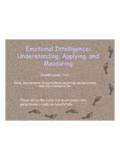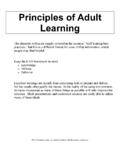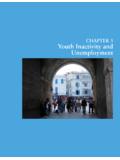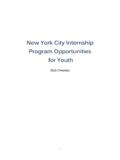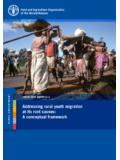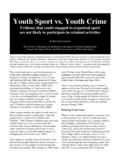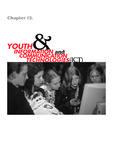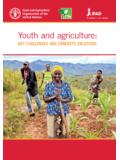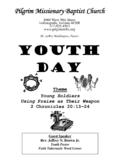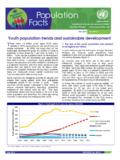Transcription of At-risk Youth & Resilience Factors - Vision Realization
1 At-risk Youth & Resilience FactorsRandall Grayson, , developmental, & organizational psychology applied to utilize the audio that accompanies this presentation in order to benefit fully Randall Grayson, of this session Who are At-risk Youth ? Why do some At-risk Youth make it while others do not? Very brief overview of how camps can foster resiliency Provide resources for further information Randall Grayson, / Caveats Better to have fuzzy whole picture than a small, clear piece of it Focus is on understanding nature of At-risk status and resiliency How to increase resiliency domains would be a session for each one in itself Randall Grayson, ) Defining At-risk Youth i) Characteristics ii) Continuum of risk iii) Outcomes for At-risk Youth iv) A few statistics 2) Resiliency i) Thinking about resiliency ii) Studies that examine resiliency iii) Resiliency characteristics by the 5 domains 3) Fostering resiliency at camp 4)
2 Benchmarking 5) Useful web sites 6) Book shelf Randall Grayson, are your expectations?Why are you here? Randall Grayson, are At-risk Youth ?You tell me Randall Grayson, characteristics of At-risk Youth Chronic poverty Single parent(Stress, excessive work load, long hours, depression,lack of social support, etc.) Poor parenting skills(family discord, negative role models, lack of structure and rules, etc.), Large family Poor schools Bad grades Bad neighborhoods(drugs, lack of things to do, lack of community support, violence, etc.), Negative peer influence Minority status Low birth weight Drug use by self or caregiver Poor social skills Randall Grayson, along a continuum High SES Few psycho-social stressors Good schools Positive peers Good familyAt-risk BehaviorImminent RiskHigh RiskRemote RiskMinimal Risk Less positive Some stressors Single parent Bad crowd Minority status Depression Anxiety Aggression Hopelessness Poor school grades Bad crowd Smoking Early sexual activity Alcohol Legal trouble Severe school problems Hard drugs Teenage mother Been in prison Dropped out of school Randall Grayson.
3 Outcomes for At-risk Youth Teenage pregnancy Drug use Criminal or antisocial behavior (violence, theft, etc.) High school education or lower Marriage that ends in divorce or is unhealthy Low socioeconomic status Shorter life span Mental health problems Lower IQ Randall Grayson, few statistics (1 of 3) 1 in 4 children under 6 lives below the poverty line Each year spent in poverty reduces by 2 percentage points a child s chance of graduating from high school Students from low income, low skill, low education families are twice as likely to drop out as students from affluent families 77% of 8thgraders report having used alcohol. have had more than 5 drinks in the last two weeks.
4 Randall Grayson, few statistics (2 of 3) 2/3 of all high school seniors have used illegal drugs 30% of young adolescents have had sex by age 15 Only 60% use any contraception at first intercourse Teenage girls typically don t use contraception until 6-9 months after they have become sexually activeOf those, are already pregnant Teenagers who become pregnant Have fewer social resources Lower educational attainment Reduced potential earnings Children are underweight and less healthy than older mothers Randall Grayson, few statistics (3 of 3)7585951051151250123456 IQThe average IQ scores for 13-year-olds decrease markedly when their development is affected by more than two risk Factors Randall Grayson, quandaryAbout 2/3 of high risk children experience one or more negative life outcomeBut, that means that 1/3 beat the odds.
5 Randall Grayson, do some At-risk Youth make it while others fall by the wayside? Randall Grayson, & CommunityPersonalPeersFamily Randall Grayson, a few studies of risk and resiliency to offer a flavor of how researchers figure out which are the most important things to target Randall Grayson, of risk and Resilience (1 of 4) Design All children born on Kauai (Hawaii) in 1955. Follow 32 years. Measures from family, child, community, & doctor Results Of high risk children, 2/3 developed learning or behavior problems by the age of 18 Resilient children had several things in common Easy temperament Independent, autonomous, and internal locus of control Good communication and social skills Good problem-solving skills Positive self-concept Good school achievement At least moderately intelligent At least one positive care giver in home, community, or with peersKauai Longitudinal Research Randall Grayson, of risk and Resilience (2 of 4)
6 Design 100,000 children surveyed at one point in time convenience sample with an uncertain measure All assets measured at one time prevents recycling variance Results Children who avoided drug use, violence, depression, suicide, school problems, and antisocial behavior had 6 assets in common Positive peer influence Restraint / delay gratification / self-control Peaceful conflict resolution / problem-solving Achievement motivation Self-esteem Sense of future / Future sense of self / HopeSearch Institute 40 Asset Survey Randall Grayson, of risk and Resilience (3 of 4) Design Random selection of 12,118 adolescents from 80 schools Interview and survey child, parents, and school Results Family and school connectedness were central Having a strong basis of support was protective against every negative outcome except pregnancyNational Longitudinal Study on Adolescent Health Randall Grayson, of risk and Resilience (4 of 4)
7 Design Qualitatively reviewed over 100 resiliency studies Results Individual level / Personal Good social skills including empathy, communication, and prosocial behaviors Problem-solving skills A sense of control and self-esteem Future sense of self / Hope Families, schools, and community Any could be protective as long as there were positive, caring people High expectations also needed to be part of supportive context Opportunities for meaningful participationReview of Over 100 Resiliency Studies Randall Grayson, summary, Resilience is: Family Personal Genetic Friends and mentors School and communityEncompassed by ALL five domainsKey is to target as many domains as possible and to target the ones that make the most difference Randall Grayson, is: (1 of 6) Warmth Cohesion / Family as group Presence of a caring adult Absence of stress and conflict Authoritative / emotion-coaching parenting style(Mixed with authoritarian if the environment is dangerous)Key Family Characteristics Randall Grayson, is.
8 (2 of 6) Hope (future sense of self) Self-confidence and independence(Also known to psychologists as General Self-efficacy) Social skills(Responsibility, Empathy, Cooperation, Assertiveness, & interpersonal skills) Delay gratification / impulse control / restraint Stress tolerance Problem-solving Self-esteemKey Personal Characteristics Randall Grayson, is: (3 of 6) Roughly 50% of most personality characteristics is inherited, including: self-control, happiness, assertiveness, stress tolerance Intelligence (perhaps even more) Range of reaction Upper and lower bound Nutrition, prenatal care, & environment as enriching, average, or poor Gene-environment interaction Propensity does not equal behavior Story of Good GriselleGenetic influencesPerformanceA B C Randall Grayson, is.
9 (4 of 6) Positive peer influence The Nurture Assumption Search Institute survey 41% of the variance Role in group of children Popular Average Neglected Rejected Controversial Mentor one person who is crazy about the child and will be a positive role model and base of supportFriends and Mentors Randall Grayson, is: (5 of 6) High expectations of student achievement Emphasis on basic skills An orderly climate Regular evaluation of students progress w/ clear feedback Provide social support (counselors, homeroom teachers, etc.) Ample use of praise of good performance Smaller school and classroom size Homework assigned regularly Firm, but not severe discipline Widespread opportunities for children to take responsibility Higher proportion of teacher time interacting with class as a whole Active involvement in the learning and East Harlem School Randall Grayson, is.
10 (6 of 6) Connectedness Sense of place / culture / identity / pride Sense of communities neighborhoods and neighbors Opportunity for positive activity Religious community After school programs Safe, enjoyable activitiesCommunity Randall Grayson, resiliency at camp (1 of 2) Parent education and enrichment enormously boosts chance of success because more than one environment Year-round, long term services (continuity) Short term interventions tend to have little or no effect needs to last several months if not years Mentor program After school tutoring and activities Focus on Youth development, not specific problems and have a framework (resiliency, 40 assets, or.)
